You are cordially invited to attend my talk

Uncovering past secrets

Who are these nameless people of Great Dunmow who stare into the middle-distance of their 1860s photographs? Only a few bare facts are known about them – their photos all purchased from that well-known internet auction-house. The first five photos came from a single house-clearance in Sussex, so were all related to each other; whilst the sixth photo came from Ireland.
The ladies from Sussex are all wearing the same head-dress. Are they grandmother, two daughters, and grand-daughter? The small child (boy or girl?) has been photographed against the same background as the two younger women. The lady from Ireland is sitting on the same chair with the same table as the two older ladies from Sussex. Their clothing dates all of them to the first half of the 1860s.
Who are these ladies and child? All frozen for a moment in time through the lens of the photographer and nurseryman, William Stacey* of Great Dunmow. Nameless people to add to the local history of Great Dunmow.






*Even today, there is still a flower/plant shop in Great Dunmow’s High Street called ‘Stacey’s Flowers of Great Dunmow’.
You may also be interested in the following post
– The Cole family of Spitalfields Market
Saturday 14 July 2012 was the date of the latest Dunmow Flitch: the ancient English tradition of couples proving their mutual love for each other in a court of law and thus winning (or losing) a side of bacon. My previous post, The Dunmow Flitch: bringing home the bacon, gives the background to the Flitch trials and has images of The Dunmow Flitch’s past: from the fourteenth century (during the days of William Langland’s Piers Plowman and Chaucer’s The Canterbury Tales) to the nineteenth and twentieth century. Today’s post contains images of yesterday’s Flitch Trials: a very modern twenty-first century celebration of this ancient custom.
Five couples each were separately tried by a court comprising of a judge, barristers (two for The Claimants and two for The Pig/Bacon) and a jury of six maidens and six bachelors. One trial was in the morning, two in the afternoon, and a further two in the evening. My images are of the two couples on trial for their marriage during the evening’s proceedings.
In the town before the evening’s trials
 After the trial, any successful claimants of the Flitch have to kneel ‘on pointed stones’ and swear the Flitch Oath. This van acted as the platform to hold the Judge, Court Chaplain and the successful Claimants so that they could kneel on ‘pointed stones’ and swear the Flitch Oath in full view of the watching town.
After the trial, any successful claimants of the Flitch have to kneel ‘on pointed stones’ and swear the Flitch Oath. This van acted as the platform to hold the Judge, Court Chaplain and the successful Claimants so that they could kneel on ‘pointed stones’ and swear the Flitch Oath in full view of the watching town.
 Shortly after 6:30pm, sturdy yeoman of the town carried the Flitch of Bacon and the empty Flitch chairs to the court-house in Talberds Ley. Successful Claimants are carried on these chairs back through the town after the trial.
Shortly after 6:30pm, sturdy yeoman of the town carried the Flitch of Bacon and the empty Flitch chairs to the court-house in Talberds Ley. Successful Claimants are carried on these chairs back through the town after the trial.
 Carrying the Flitch and empty chairs through the town before the trial.
Carrying the Flitch and empty chairs through the town before the trial.
 The Flitch of Bacon.
The Flitch of Bacon.
 The brand new Flitch Chair. The chair was hand made by a 21 year-old student of Leeds College of Art. He was a former pupil of the Helena Romanes school on Great Dunmow’s Parsonage Down.
The brand new Flitch Chair. The chair was hand made by a 21 year-old student of Leeds College of Art. He was a former pupil of the Helena Romanes school on Great Dunmow’s Parsonage Down.
 The original Flitch chair is kept in the parish church in Little Dunmow and brought out for the Dunmow Flitch.
The original Flitch chair is kept in the parish church in Little Dunmow and brought out for the Dunmow Flitch.
 Members of the Court. In the front, the Court Usher and the Clerk of the Court; followed by the four barristers (including BBC Essex’s Dave Monk). At the back, the Court Chaplain, the Reverend Canon David Ainge (the current vicar of Great Dunmow’s St Mary’s church).
Members of the Court. In the front, the Court Usher and the Clerk of the Court; followed by the four barristers (including BBC Essex’s Dave Monk). At the back, the Court Chaplain, the Reverend Canon David Ainge (the current vicar of Great Dunmow’s St Mary’s church).
 Reverend Canon David Ainge, the vicar of Great Dunmow, latest in a long line of distinguished vicars of Great Dunmow; followed by the Judge, Michael R Chapman.
Reverend Canon David Ainge, the vicar of Great Dunmow, latest in a long line of distinguished vicars of Great Dunmow; followed by the Judge, Michael R Chapman.
In the court-room
 The Court Usher, the Judge and the Court Chaplain before the trial.
The Court Usher, the Judge and the Court Chaplain before the trial.
 The swearing in of the jury: 6 maidens and 6 bachelors.
The swearing in of the jury: 6 maidens and 6 bachelors.
 The swearing in of the first of the evening’s Flitch Claimants.
The swearing in of the first of the evening’s Flitch Claimants.
 The shenanigans of the barristers: two are for the Claimants and the other two are for the Pig. The Claimants have to prove that they have never ‘wished themselves unwed’ and are happily married. The barristers for the Pig have to prove that they are not happily married and the Claimants are unworthy of winning the Pig. (It’s all very light-hearted and funny – nothing too serious at all.)
The shenanigans of the barristers: two are for the Claimants and the other two are for the Pig. The Claimants have to prove that they have never ‘wished themselves unwed’ and are happily married. The barristers for the Pig have to prove that they are not happily married and the Claimants are unworthy of winning the Pig. (It’s all very light-hearted and funny – nothing too serious at all.)
 The verdict from the jury for the first of the evening’s couples: they successfully fought their case!
The verdict from the jury for the first of the evening’s couples: they successfully fought their case!
 The swearing in of the second couple.
The swearing in of the second couple.
 Dave Monk vigorously defending the Pig.
Dave Monk vigorously defending the Pig.
 Dave Monk taking extreme umbrage at comments the Judge made about his wife.
Dave Monk taking extreme umbrage at comments the Judge made about his wife.
 The verdict from the jury for the second of the evening’s couples: they also successfully fought their case!
The verdict from the jury for the second of the evening’s couples: they also successfully fought their case!
The procession through the town to the location of Great Dunmow’s ancient market
 Shortly before 10pm the Court moved in procession from the Court’s location in Talberds Ley, up through Stortford Road and then down into Market Street.
Shortly before 10pm the Court moved in procession from the Court’s location in Talberds Ley, up through Stortford Road and then down into Market Street.
 Great Dunmow’s Town Crier and Mayor.
Great Dunmow’s Town Crier and Mayor.
 Carrying the winners of the Flitch aloft.
Carrying the winners of the Flitch aloft.
 The first couple kneeling on pointed stones whilst listening to the Flitch Oath and Sentence.
The first couple kneeling on pointed stones whilst listening to the Flitch Oath and Sentence.
 The second couple kneeling on pointed stones whilst listening to the Flitch Oath and Sentence.
The second couple kneeling on pointed stones whilst listening to the Flitch Oath and Sentence.
 The end of the day’s proceedings.
The end of the day’s proceedings.
The Flitch Oath
You shall swear by the Custom of our Confession
That you never made any Nuptial Transgression
Since you were married Man and Wife
By Household Brawls or Contentious Strife
Or otherwise in Bed or at Board
Offended each other in deed or in word
Or since the Parish Clerk said Amen
Wished yourselves unmarried again
Or in a Twelvemonth and a day.
Repented not in thought any way
But continued true and in Desire
As when you joined Hands in holy Quire
The Sentence
If to these Conditions without all fear
Of your own accord you will freely swear
A Gammon of Bacon you shall receive
And bear it hence with love and good Leave
For this is our Custom at Dunmow well known
Though the sport be ours, the Bacon’s your own.
[This last line is normally said to great rousing cheers from the watching audience and the yeomen throwing their caps in the air.]
If you liked this post, you may also like this
– The Dunmow Flitch: bringing home the bacon
– Thomas Bowyer, weaver and martyr of Great Dunmow d.1556
Copyright notice
This article is © Essex Voices Past 2012. Unless otherwise indicated, the images on this post are also © Essex Voices Past 2012.
This Saturday, 14 July 2012, heralds the much awaited ancient custom of The Dunmow Flitch whereby couples from all over Britain (and, in recent years, the world) come to Dunmow to persuade a formal court that they have not wished themselves unwed for a year and day. If they win the court case, and persuade the judge and jury of their love for each other, then they win a ‘flitch of bacon’ (a large side of cured pig). This court is very formal with a judge, jury and barristers: one barrister defends the Pig, and the other is for the couple. Any couple who wins the Flitch is said to be ‘bringing home the bacon’ and is carried aloft on the ancient Dunmow Flitch chair by ‘yeomans’ in a parade through the streets of the town . Once the parade arrives in the market place, the winners of the Flitch have to kneel on pointed stones and say The Oath.
The Flitch Oath
You shall swear by the Custom of our Confession
That you never made any Nuptial Transgression
Since you were married Man and Wife
By Household Brawls or Contentious Strife
Or otherwise in Bed or at Board
Offended each other in deed or in word
Or since the Parish Clerk said Amen
Wished yourselves unmarried again
Or in a Twelvemonth and a day.
Repented not in thought any way
But continued true and in Desire
As when you joined Hands in holy Quire
The Sentence
If to these Conditions without all fear
Of your own accord you will freely swear
A Gammon of Bacon you shall receive
And bear it hence with love and good Leave
For this is our Custom at Dunmow well known
Though the sport be ours, the Bacon’s your own.
[This last line is normally said to great rousing cheers from the watching audience.]
If you are in the area of North Essex, I do recommend watching one of these very funny and witty trials. Sadly, this year’s trials will be without the lovely agony aunt Claire Rayner, who died in 2010. She was always tremendous fun at the Trials and gave a wonderful performance to the audience. It was fitting that during the last Dunmow Flitch in 2008, she and her husband took ‘home the bacon’ as they successfully fought their case that they hadn’t argued for a year and a day. She will be much missed at this year’s Trials.
The ‘custom of the flitch’ appears to have started in the twelfth or thirteenth century by the prior of the priory at Little Dunmow – although no evidence has survived to verify this. The first recorded mention of the Flitch is by William Langland in his 1362 ‘The Vision of Piers Plowman’ and his contemporary, Geoffrey Chaucer in his ‘Canterbury Tales’. Both of these authors, writing in the fourteenth century, use words that imply that this custom was, at the time of their writings, well known.
In ‘The Wife of Bath’s Tale’, Chaucer said
The bacon was nat fet for hem, I trowe,
That som men han in Essex at Dunmowe.
 ‘The Wife of Bath’ from Caxton’s second edition of The Canterbury Tales,
‘The Wife of Bath’ from Caxton’s second edition of The Canterbury Tales,
(circa last half fifteenth century) shelfmark G. 11586, fol. b5 v, © British Library Board.
In ‘The Vision of Piers Plowman’ Langland wrote
Though they go
to Dunmow,
they never fetch
the Flitch.
 William Langland, Piers Plowman (England, 1st half of the 15th century)
William Langland, Piers Plowman (England, 1st half of the 15th century)
shelfmark Harley 2376 f.1, © British Library Board.
Confusingly, there are two places next to each other in Essex called Dunmow: Great Dunmow and Little Dunmow. During the medieval and Tudor period, Little Dunmow was normally styled as ‘Dunmow Parva ’ and Great Dunmow was ‘Muche Dunmow’. It was within Dunmow Parva that there was Austin priory which, according the Valor Ecclesiasticus of 1535, had the net value of £150 3s 4d. The priory was dissolved in 1536 under the Act for the Dissolution of the Lesser Monasteries. However, before it was dissolved, there is recorded instances of the Dunmow Flitch taking place at the Priory in 1445 and 1510.
During the eighteen century, the ancient custom of The Flitch was moved from the village of Little Dunmow to the nearby town of Great Dunmow where it is now held every four years.
British Pathé film archive
The Pathé film archive has some interesting silent film-reels of the Dunmow Flitches held in the 1920s at Ilford: 1920s Dunmow Flitch
Postcards and magazine articles









Dunmow Flitch


A Note on the Flitch Trials held between 1890-1906, and 1912-1913
Between the years 1890 to 1906, and 1912 to 1913, the Dunmow Flitch was held every year within the town and the events of the day reported in newspapers such as Essex County Chronicle, Essex Standard, Essex County Standard, Pall Mall Gazette, and The Sketch. From these newspapers, the author Francis W Steer of the Essex Record Office in his book The History of the Dunmow Flitch Ceremony drew up a list of all those that took part in the Trials. This list includes those that claimed the Flitch, members of the jury (young men and women of the area all under 18), barristers and judges. The judge, barristers, and jury were all chiefly from Great Dunmow and its surrounding villages.
Sadly, these lists contain the names of sons, brothers, lovers, and husbands of many who marched away to war in 1914 never to return to home. One such person was my grandfather’s cousin, Harold James Nelson Kemp, son of the James and Alice Kemp, first of the White Horse, then of the Royal Oak. On the 1st August 1904 Harold was one of the young jurymen for the Flitch Trials held in a meadow near the Causeway in Great Dunmow. On 28 May 1916, he was killed in action in German East Africa (now Zambia). His brother, Gordon Parnall Kemp, was killed in action the following year in the mud and gore of Passchendaele (the 3rd Battle of Ypres).
Mr J N Kemp of the Golden Lion, The Conge, Great Yarmouth for many years resident in Dunmow has received information from the British South Africa Co that his son Harold has been killed in action with the Northern Rhodesian Force. Harold was educated at the Dunmow Church Schools. He started in life with the late Mr F J Snelland at his death continued with Mr Gifford, under whose instructions he became very proficient and acting on Mr Gifford’s advice obtained a situation in the Council offices at Sidcup where his instructions stood him in good steed. From there he joined the R.S.A. Police and became the manager of the Police Review. When he had served his time he obtained a good situation with Messrs. Arnold and Co of Salisbury and London. On the outbreak of the war he volunteered for active service and now, alas, his end. He was a member of the Dunmow church choir from his school days up to the time of his leaving Dunmow and he will be remembered as singing solo in the old church the Sunday before his departure for South Africa.
From Essex Chronicle 9 June 1916
Mr J N Kemp for many years a resident at Dunmow and now of Yarmouth has received the sad news that his second son, Gordon, has been killed in action in France.
From Essex Chronicle 19 October 1917


If you liked this post, you may also like this
– The Dunmow Flitch Trials 2012
Copyright notice
This article is © Essex Voices Past 2012. Unless otherwise indicated, the images on this post are also © Essex Voices Past 2012.
Update 19 June 2012: thegentleauthor of Spitalfields Life has today published my story with more accompanying photos: The Coles of Brushfield Street
I have long resisted the temptation to publish any stories from my own non-Essex family history on my blog. But today, because of this post with images of Spitalfields Market and Brushfield Street on the delicious Spitalfields Life blog and the recent BBC programme about the market traders of New Spitalfields Market, I can resist no longer. For the first time on my blog, I will be publishing a non-Essex story from the Victorian period. Although, if you persevere to the end of this post, you will see how this post is most definitely related to my interest in the local history of Great Dunmow.
I must be among a very rare number of 21st Century Londoners who can visit the East London home of my ancestors and walk in their steps. Many of my Victorian ancestors lived in the street of Bishopsgate in the City of London and its neighbouring street, Brushfield Street. Whilst I can no longer visit my ancestors’ substantial Victorian Bishopsgate home and factory, as it was compulsory purchased and swept away in the 1880s by the powerful Great Eastern Railway so they could build the mighty Great Eastern Hotel in its place, I can still visit my ‘ancestral’ home in Brushfield Street on the edge of Spitalfields Market. This market is an ancient market that lies on the edge of City of London and for centuries, was THE fruit and veg market of London. Sadly, now, as is the fate of many other ancient markets, it is the home of swanky boutiques, shops and posh eateries with house-prices to match. If you want to read about the history of the area, then I do recommend the Spitalfields Life blog.
One of the major roads next to Spitalfields Market is Brushfield Street. Up until the 1870s, Brushfield Street’s name was ‘Union Street East’. Halfway down, on the right-hand side is a parade of shops all dating from the 18th century. Many readers of my blog may be familiar with the restored lovely Victorian frontage of the food shop A Gold and the next door women’s fashion shop, Whistles.
If you do know these two shops, have you ever looked up above their signage and spotted a small plaque on the wall in between the two? This is a plaque from 1871 marking the Christchurch Middlesex parish boundary.
And here is the same plaque from a photo I took about 20 years ago before the area was redeveloped.
There on the wall for all of London to see, is the name of my great-great grandfather, R. A. Cole!
*-*-*-*-*-*-*-*-*-*-*-*-*-*-*-*-*-*-*-*-*-*-*-*-*-*-
Robert Andrew Cole was a grocer and tea-dealer – living above his shop and trading from the shop which is now Whistles. Robert Andrew, along with his wife, Sarah Elizabeth (nee Ollenbuttel) and their five children, William, Sarah, Margaret, Robert and Arthur, all lived in Brushfield Street/Union Street East for some 30 years from the 1850s until the 1880s when the market was redeveloped and Robert Andrew Cole retired to Walthamstow. As an aside, I do find it ironic that today’s swanky redeveloped Spitalfields Market is now known as Old Spitalfields Market. In Robert Andrew Cole’s day, it was a brand spanking new, and perhaps an unwanted market with posh new buildings! Its very existence and construction was probably one of the reasons why the Coles gave up their shop and retired to the countryside of Walthamstow.
For many years, Robert Andrew Cole was also a churchwarden of the nearby stunning Hawksmoor church, Christchurch, Spitalfields and also the Governor and Director of the Poor of the parish of Christchurch Spitalfields. So he must have been amongst some of the wealthiest of this poor east London parish. In circa 1869-1870, Union Street East was renamed to Brushfield Street, and it is possibly the renaming of this street which lead to the church boundary being marked in the wall in 1871. Hence churchwarden R. A. Cole’s name was recorded for posterity in the brick-work and fabric of Brushfield Street. He must have been a very proud man when his name was unveiled!
However, despite their standing in the community, the Cole’s time in Brushfield Street was not an entirely happy time. Two of the Cole children, Sarah Elizabeth and William Henry, succumbed to a devastating outbreak of scarletina– at that time a deadly infectious disease for many who caught it. Both children were buried in Tower Hamlets Cemetery on 2nd August 1857. William was aged only 22 months and Sarah was a month short of her 4th birthday. One can only imagine the pain and horror of their parents along with their fear and hope that their only surviving child, Robert, then aged 5, wouldn’t also fall victim to this terrible disease. This must have been an awful time for this one Victorian family living in the shadows of Christchurch Spitalfields and the fruit and veg market. However, their son Robert, didn’t become another victim (for, if he had, I wouldn’t be writing their story, as he’s my great-grandfather). Eight months after burying their two children, a new child, Margaret was born, and a further year later, Arthur was born. Sadly, Margaret also didn’t survive childhood and once again, in 1869, this small family of Union Street East buried one of their own in one of the two Cole family graves in Tower Hamlets Cemetery.
I have often pondered the fate of this small east-end family. Of the five children, only two survived into adulthood, and of those two, only one had children of his own. Arthur Cole died a bachelor in his 50s and was buried in the second Cole family grave in Tower Hamlets cemetery alongside his mother, grandparents, great-aunts, and great-uncles – true Londoners who had worked, lived and died in the eastend of the 18th and 19th century. Robert Andrew Cole, grocer and tea-dealer of Spitalfields Market, was buried in the same grave as his three children who hadn’t survived childhood. Robert Cole, the only child of Robert Andrew and Sarah Elizabeth Cole who went on to marry and father his own children, married Louisa Parnall. Louisa was a member of a fantastically successful Welsh family of industrialists and philanthropists who had a substantial Victorian clothes-making factory on Bishopsgate: the Parnalls of Carmarthenshire and Bishopsgate.
As I said at the start of this post, it is not often a 21st century person can visit the home their Victorian ancestors within the East End of London. However, not only can I visit my ancestors home, but I can also see them and almost feel and touch them. Here are three members of the Cole family of Spitalfields Market in their Sunday-best finery, captured forever through the lens of the east-end photographer, Elias Gottheil, sometime in the mid 1860s.

Robert Andrew Cole, born 10 February 1819, Anthony Street, St George in the East, east London, baptised 7 March 1819 in the parish church of St George in the East. Married 25 December 1850 St Thomas’ Church, Stepney to Sarah Elizabeth Ollenbuttel. Died March 1895 in Walthamstow. Buried in one of two Cole family graves in Tower Hamlets Cemetery. Grocer and tea-dealer of Spitalfields Market for over 30 years. Upper churchwarden of Christchurch Spitalfields c1870-74, member of several parish committees such as the committee founded by G. Fournier in the 1840s to carry out charity-work, and Governor and Director of the poor of the parish.

Robert Cole – eldest child of Robert Andrew and Sarah Elizabeth (nee Ollenbuttel) Cole, born 4 May 1852 in Tunbridge Wells (I have no idea why he was born here). Married 11 January 1880 in St Thomas, Mile End Old Town to Louisa Parnall (great-niece of Robert and Henry Parnall of Bishopsgate). Died 17 June 1927 in Raynes Park, South London. Buried in Putney Vale Cemetery, London. Grocer and teadealer.

Margaret Cole, baptised 28 March 1858 at Christchurch Spitalfields. Buried 20 January 1869 in Tower Hamlets Cemetery aged 11 years. The child in this photo looks to be about 7 or 8 years old, which dates all three photos to approximately the mid 1860s.
Robert Cole and Louisa Parnall. Tintype photos possibly taken at their betrothal, before their January 1880 marriage. It was Louisa Parnall’s sister, Alice Parnall, who along with her husband, James Nelson Kemp, left East London to live in Great Dunmow, first in the White Horse and then the Royal Oak. And, whilst I was researching the Parnall family and the Kemps of Great Dunmow in the Essex Record Office, I stumbled across the town’s Tudor churchwarden accounts and thus sparked the flame of my passion in discovering the lost voices of Tudor Great Dunmow.
If you are ever fortunate enough to be in the Spitalfields Market area of East London, take a stroll down Brushfield Street and look at the plaque there marking the parish boundary of Christchurch, Middlesex. Then look into the windows of Whistles women’s clothes shop and imagine the Victorian tragedy and triumph that went on between those four walls and the drama of the daily family life of the grocer and tea-dealer, Robert Andrew and Sarah Elizabeth Cole.
(c) Essex Voices Past 2012
Genealogist Thomas MacEntee of Geneabloggers runs a great website for genealogists. He suggests ‘Daily Blogging Prompts’ to help inspire bloggers to write genealogical posts. In the spirit of one of his Prompts, Follow Friday, my post today contains my top 10 Essex related websites for genealogical and local history research.
1. For archives, Essex Record Office’s online catalogue: http://seax.essexcc.gov.uk/
2. Ancestor owned or ran a pub in Essex? Try Pub History
Royal Oak pub in Great Dunmow. Left picture has the figure of the landlord, James Nelson Kemp (my grandfather’s uncle), and the right picture is of his son, Gordon Parnall Kemp (my grandfather’s cousin), killed in the Great War and commemorated on the town’s War Memorial along with his brother, Harold.
3. The history of various towns and villages in Essex: http://www.historyhouse.co.uk/
4. The early-modern witches of Essex: http://www.witchtrials.co.uk/ (This site also contains an essay by me which I wrote when I first started my research into witchcraft in early-modern Essex – see if you can spot it!)
5. Essex churches: http://www.essexchurches.info/
6. Roll of Honour for the war dead of Essex: http://www.roll-of-honour.com/Essex//
7. Francis Firth for images of Essex past: http://www.francisfrith.com/essex/
8. For postcards of Essex towns and villages: http://www.ebay.co.uk
9. The Recorders of Uttlesford’s history: http://www.recordinguttlesfordhistory.org.uk/
10. Website with links to early-modern and modern Essex: Genmaps – Essex
And, of course, if your ancestor lived in early-modern Great Dunmow, then this website, Essex Voice Past!
Another one to add to my list!
Update 9 March 2012 at 19:30: I’ve realised I’ve made a glaring admission in my Top 10. This one is definitely up there amongst my favourite sites.
Was you ancestor in a workhouse? This is an amazing site, be prepared to lose a few hours pouring over it!: http://www.workhouses.org.uk/
Have I missed any of your favourites? Let me know…
*-*-*-*-*-*-*-*-*-*-*-*-*-*-*-*-*
This blog
If you want to read more from my blog, please do subscribe either by using the Subscribe via Email button top right of my blog, or the button at the very bottom. If you’ve enjoyed reading this post, then please do Like it with the Facebook button and/or leave a comment below.
Thank you for reading this post.
You may also be interested in the following
– The craft of being a historian: Research Techniques
– The craft of being a historian: Analysing primary sources
– The craft of being a historian: Using maps for local history
– The craft of being a historian: Online resources
© Essex Voices Past 2012-2013.
Genealogist Thomas MacEntee of Geneabloggers runs a great website for genealogists. He suggests ‘Daily Blogging Prompts’ to help inspire bloggers to write genealogical posts. His prompt ‘Thankful Thursday’ is all about expressing gratitude for someone/something connected to your own personal family history. My own ‘someone’ was Great Dunmow’s 1960s & 70s local historian, Dorothy Dowsett.
No local history of Great Dunmow is complete without reference to her work. She was a lifelong resident of Great Dunmow and had vast knowledge about her home town which she shared in her local history books and articles in the local magazine, Essex Countryside. I owe Dorothy Dowsett’s work a debt of gratitude both for my academic research on my dissertation into Tudor & Reformation Great Dunmow and also for her work on Edwardian and early 1900s Great Dunmow.
Amazingly, in one of her books on Great Dunmow, Through all the changing seasons, I found a photo of my grandfather’s aunt, uncle and their children (my grandfather’s cousins), the Kemps of the White Horse pub and the Royal Oak, Great Dunmow. She was a contemporary of my grandfather’s cousins, and I would have loved to have sat and talked to her about them. Particularly to hear her memories of Gordon and Harold Kemp, two sons of Great Dunmow, tragically killed in the Great War.
So my own ‘Through all the changing Seasons’ is dedicated to the memory of Great Dunmow’s local historian, Dorothy Dowsett.
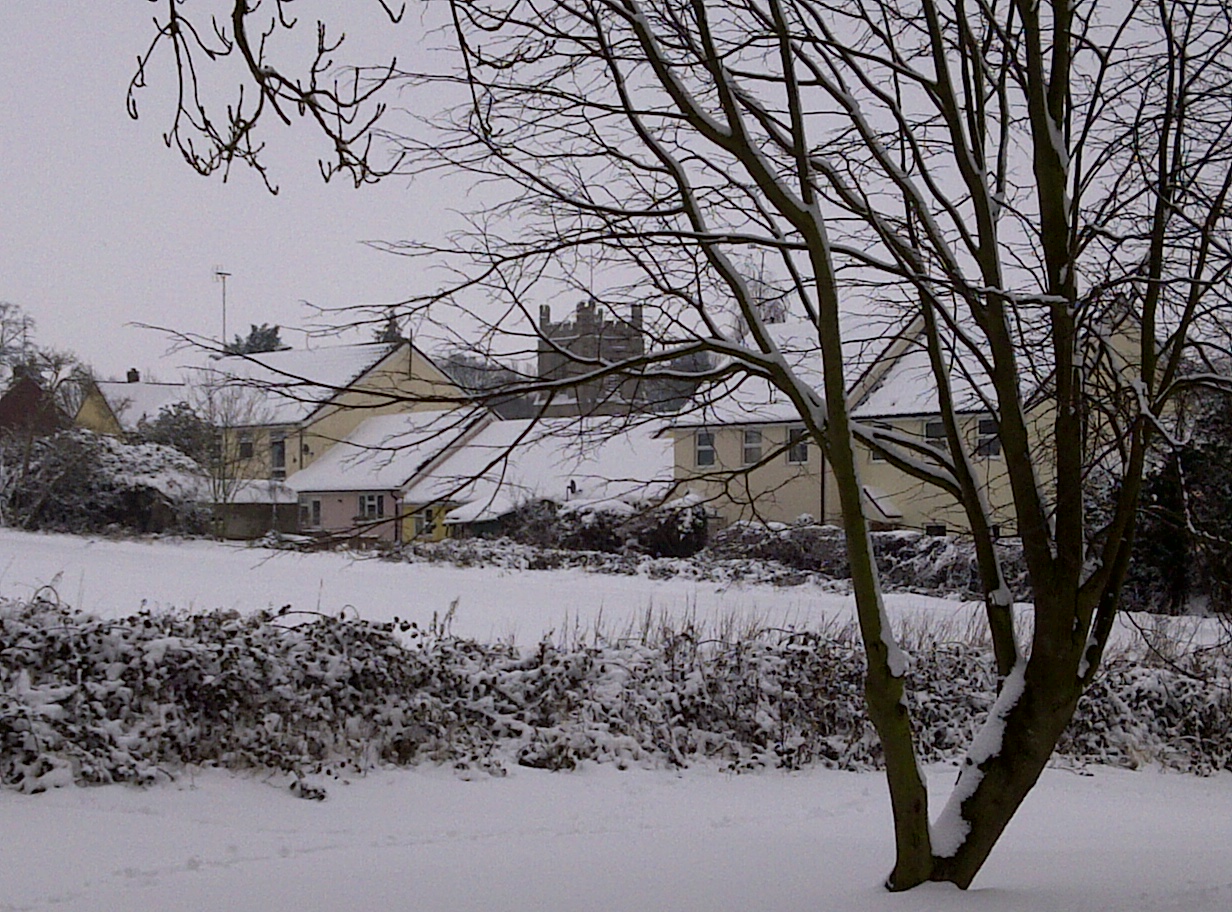 St Mary the Virgin and Church End, Great Dunmow,
St Mary the Virgin and Church End, Great Dunmow,
February 2012, © Essex Voices Past 2012.
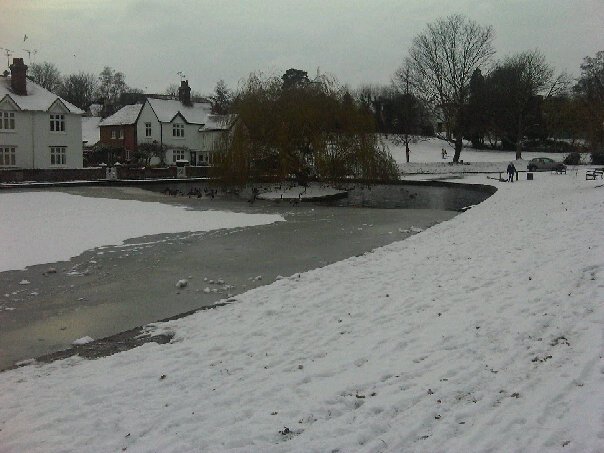 Dr’s Pond, Great Dunmow,
Dr’s Pond, Great Dunmow,
December 2010, © Essex Voices Past 2012.
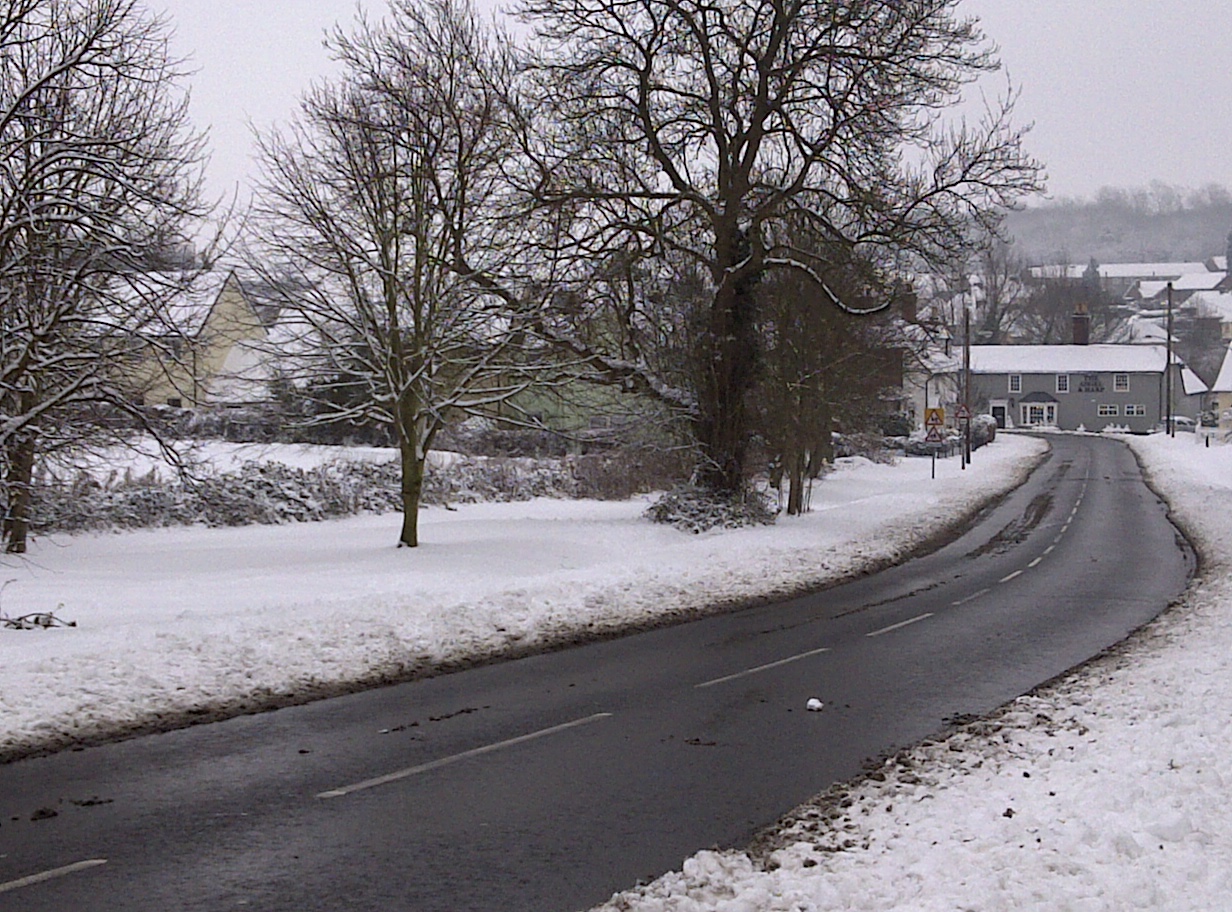 Lime Tree Hill, leading down to Church End, Great Dunmow,
Lime Tree Hill, leading down to Church End, Great Dunmow,
February 2012, © Essex Voices Past 2012.
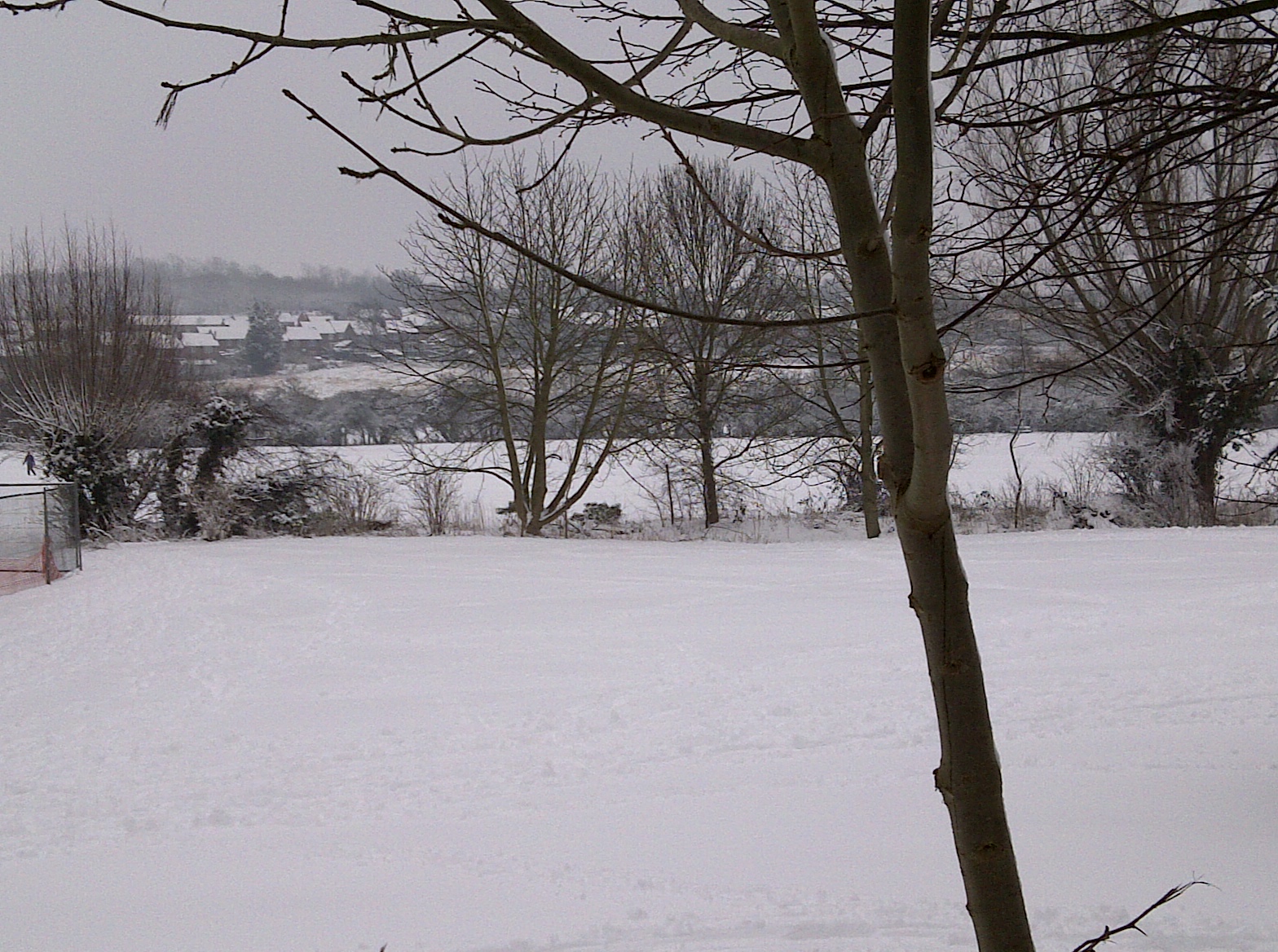 Overlooking Merks Hall and Stebbing, from The Causeway, Great Dunmow,
Overlooking Merks Hall and Stebbing, from The Causeway, Great Dunmow,
February 2012, © Essex Voices Past 2012.
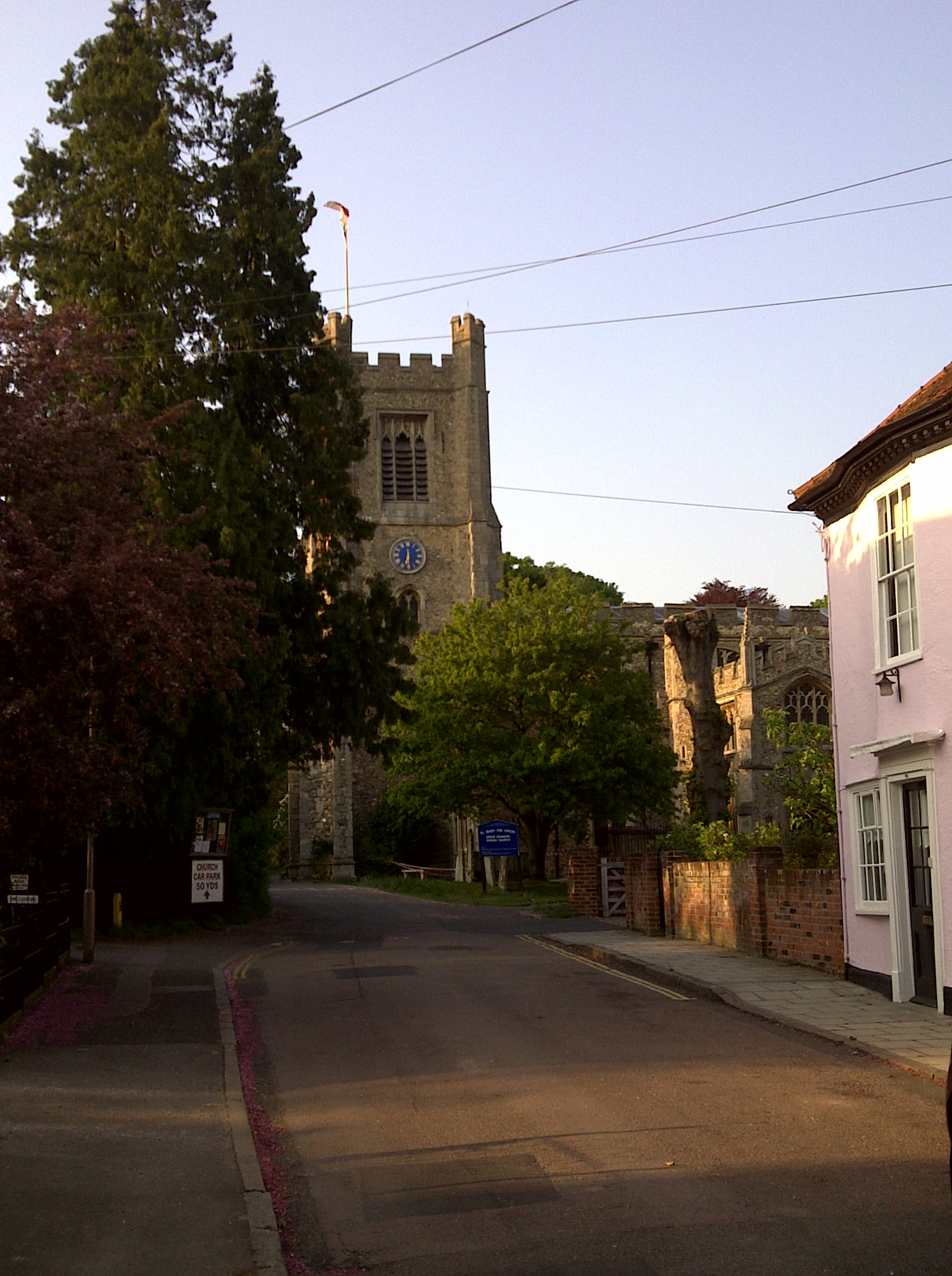 St Mary the Virgin, Great Dunmow,
St Mary the Virgin, Great Dunmow,
Spring 2011, © Essex Voices Past 2012.
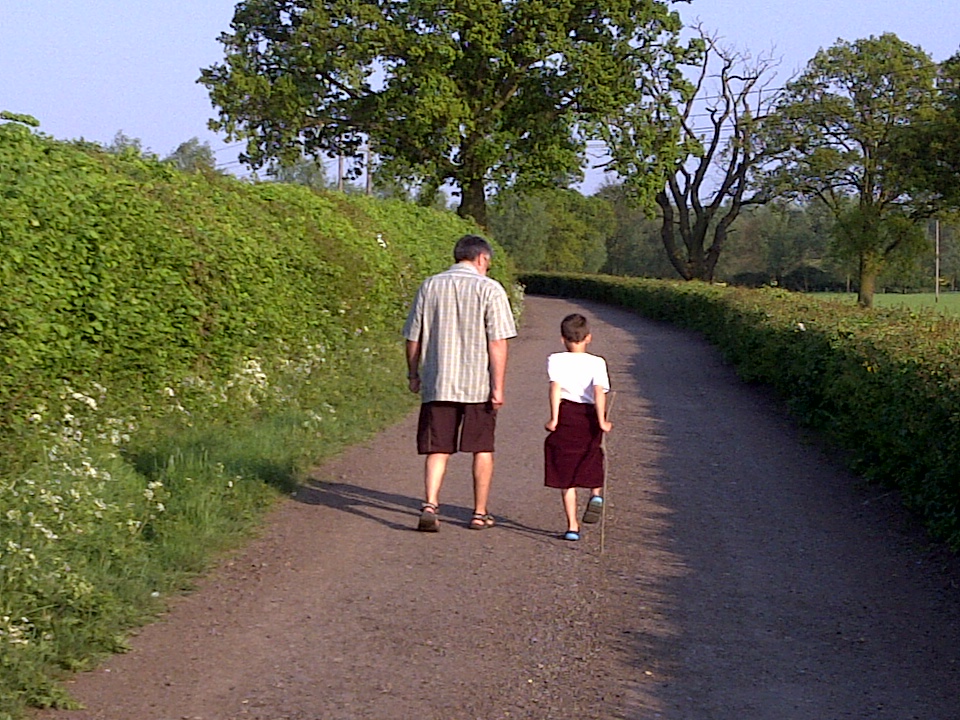 On the road between Bigods and the church at Church End, Great Dunmow,
On the road between Bigods and the church at Church End, Great Dunmow,
Spring 2011, © Essex Voices Past 2012.
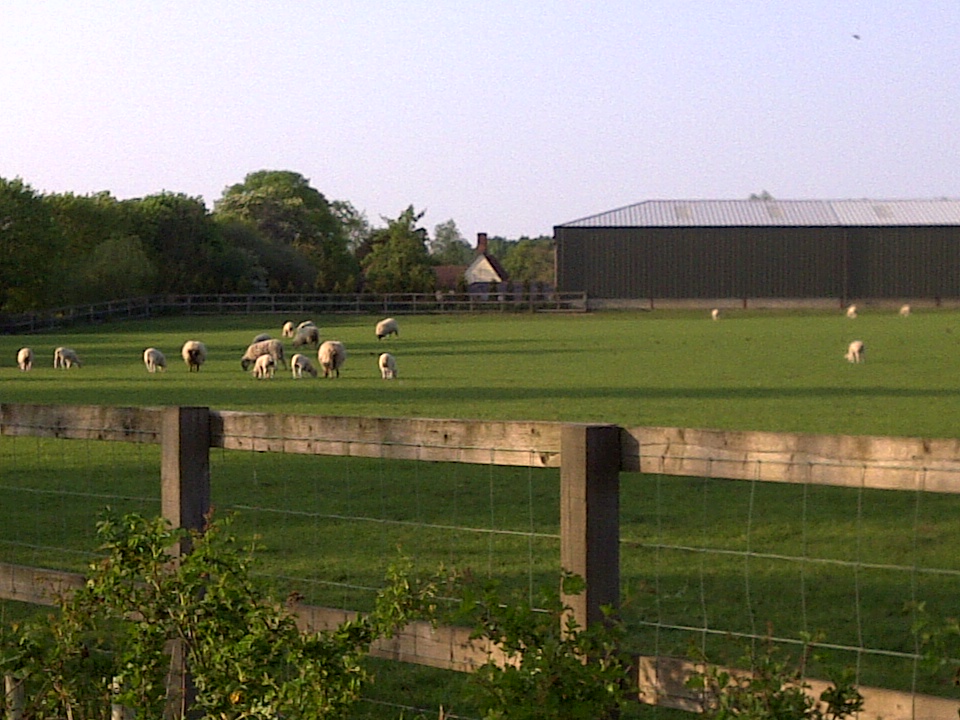 Bigods (Alfrestons) Farmhouse and spring lambs, Great Dunmow,
Bigods (Alfrestons) Farmhouse and spring lambs, Great Dunmow,
Spring 2011, © Essex Voices Past 2012.
Great Dunmow local history books
Dowsett, D., Dunmow Through The Ages (Letchworth, 1968).
Dowsett, D., Through all the changing seasons (1975).
*-*-*-*-*-*-*-*-*-*-*-*-*-*-*-*-*
This blog
If you want to read more from my blog, please do subscribe either by using the Subscribe via Email button top right of my blog, or the button at the very bottom. If you’ve enjoyed reading this post, then please do Like it with the Facebook button and/or leave a comment below.
Thank you for reading this post.
You may also be interested in the following
– Index to each folio in Great Dunmow’s churchwardens’ accounts
– Great Dunmow’s Churchwardens’ accounts: transcripts 1526-1621
– Tudor local history
– Pre-Reformation English church clergy
– Medieval Essex dialect
– Henry VIII’s Lay Subsidy 1523-1524
– The Tudor witches of Essex
– Building a medieval church steeple
– Great Dunmow’s Medieval manors
© Essex Voices Past 2012-2013.